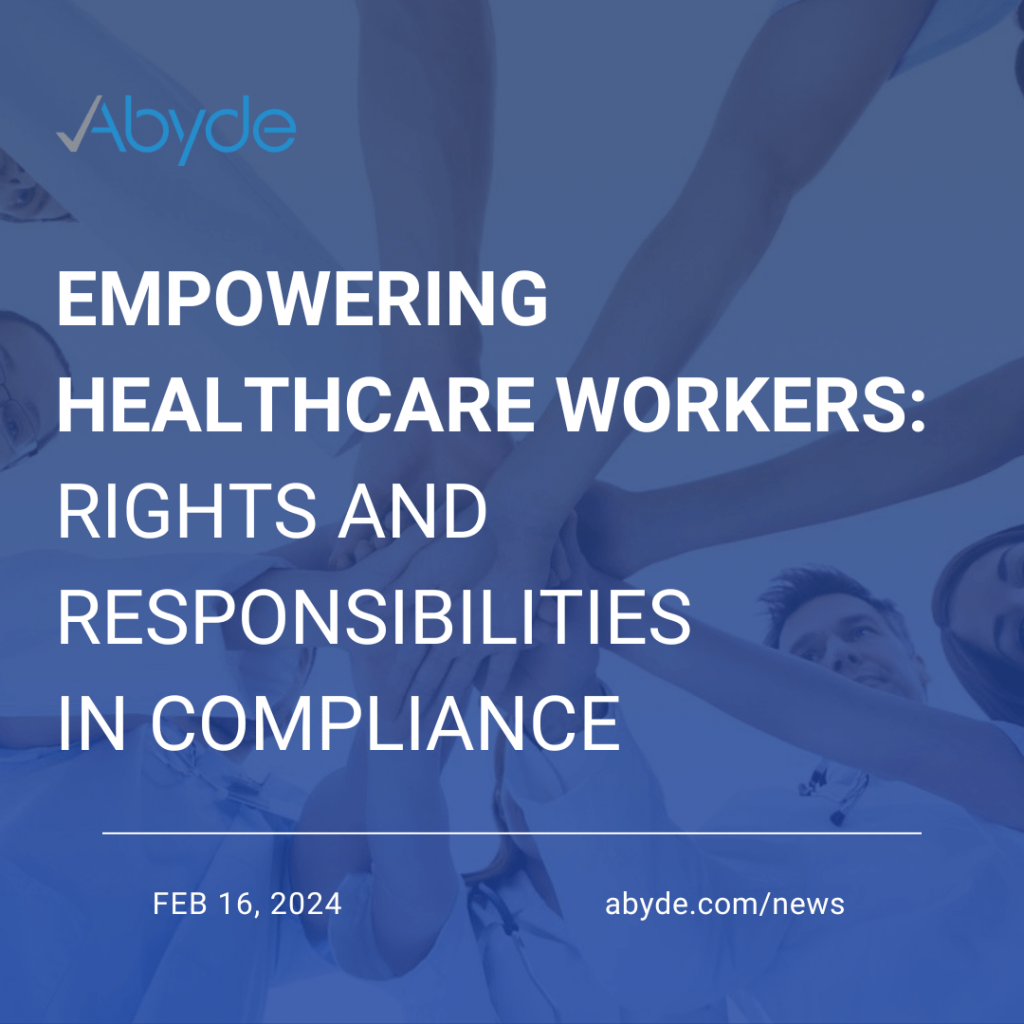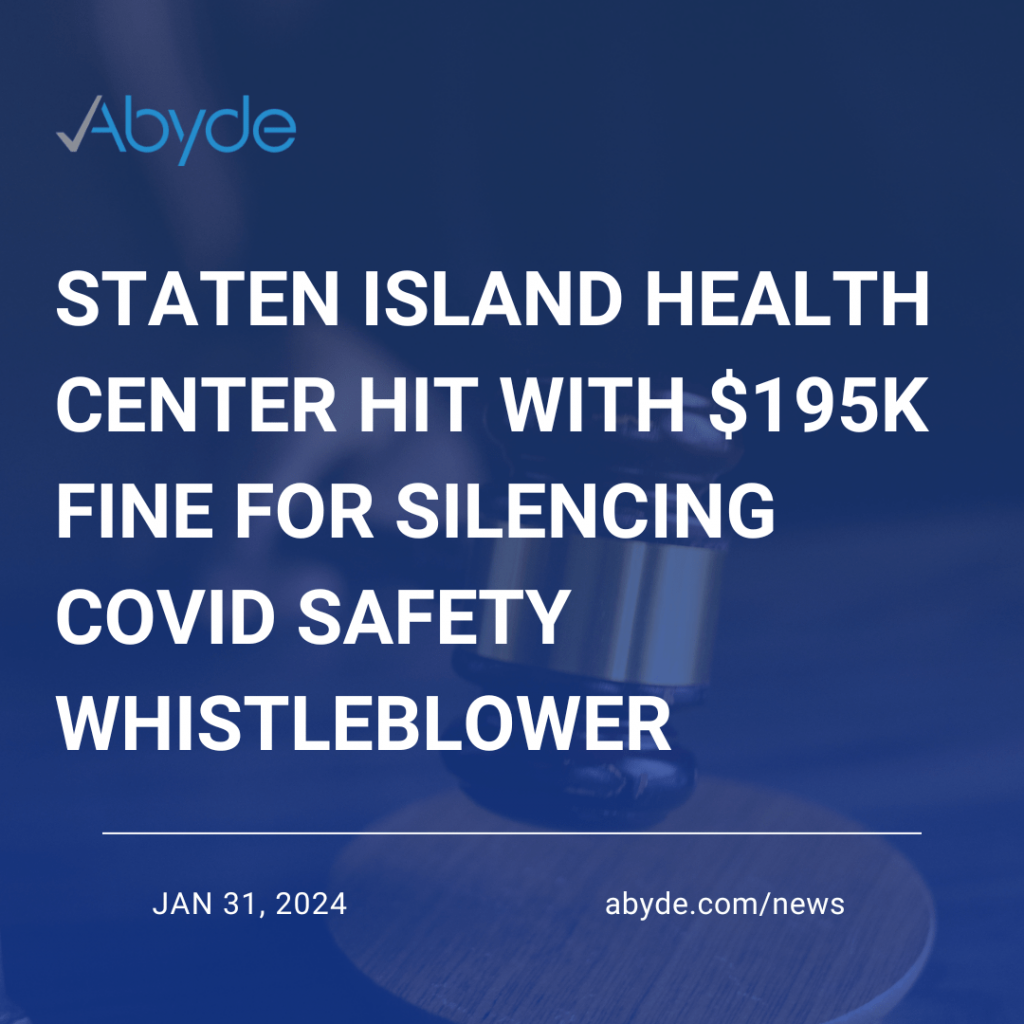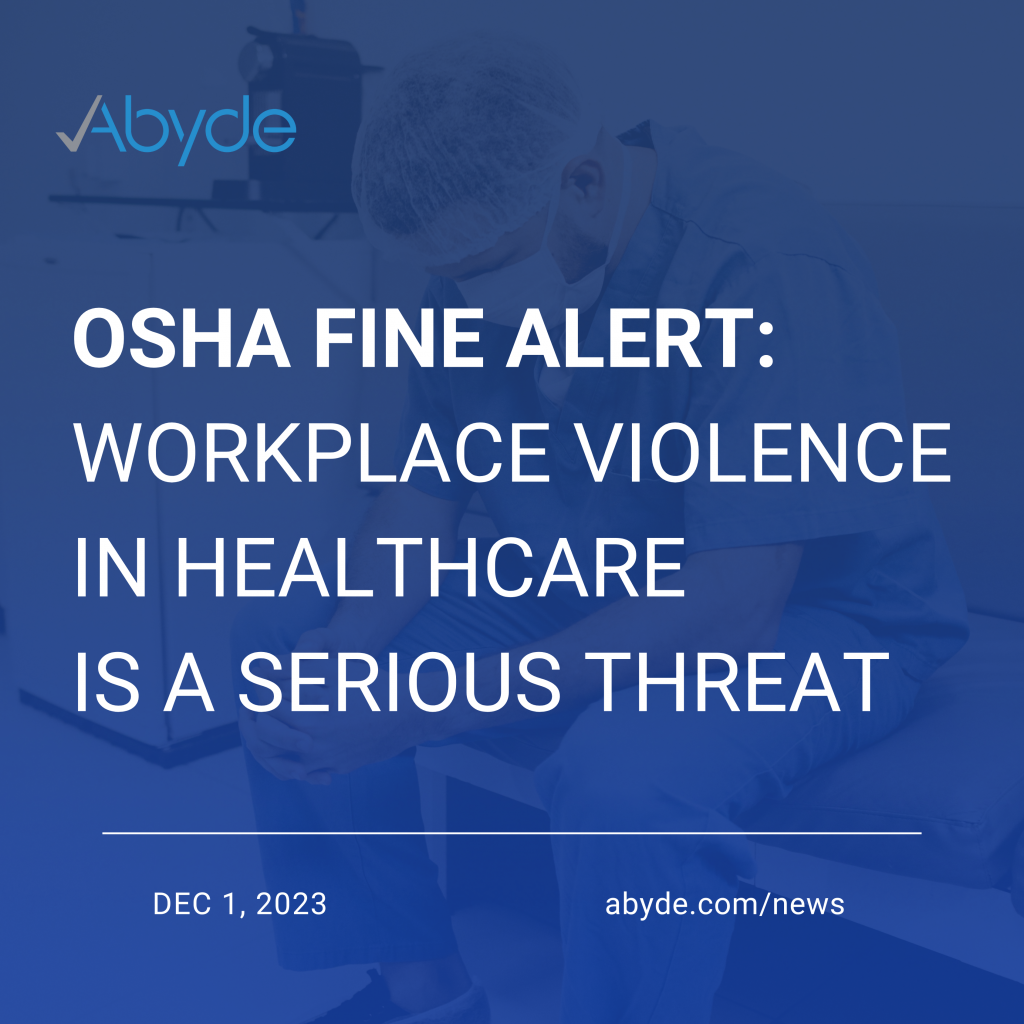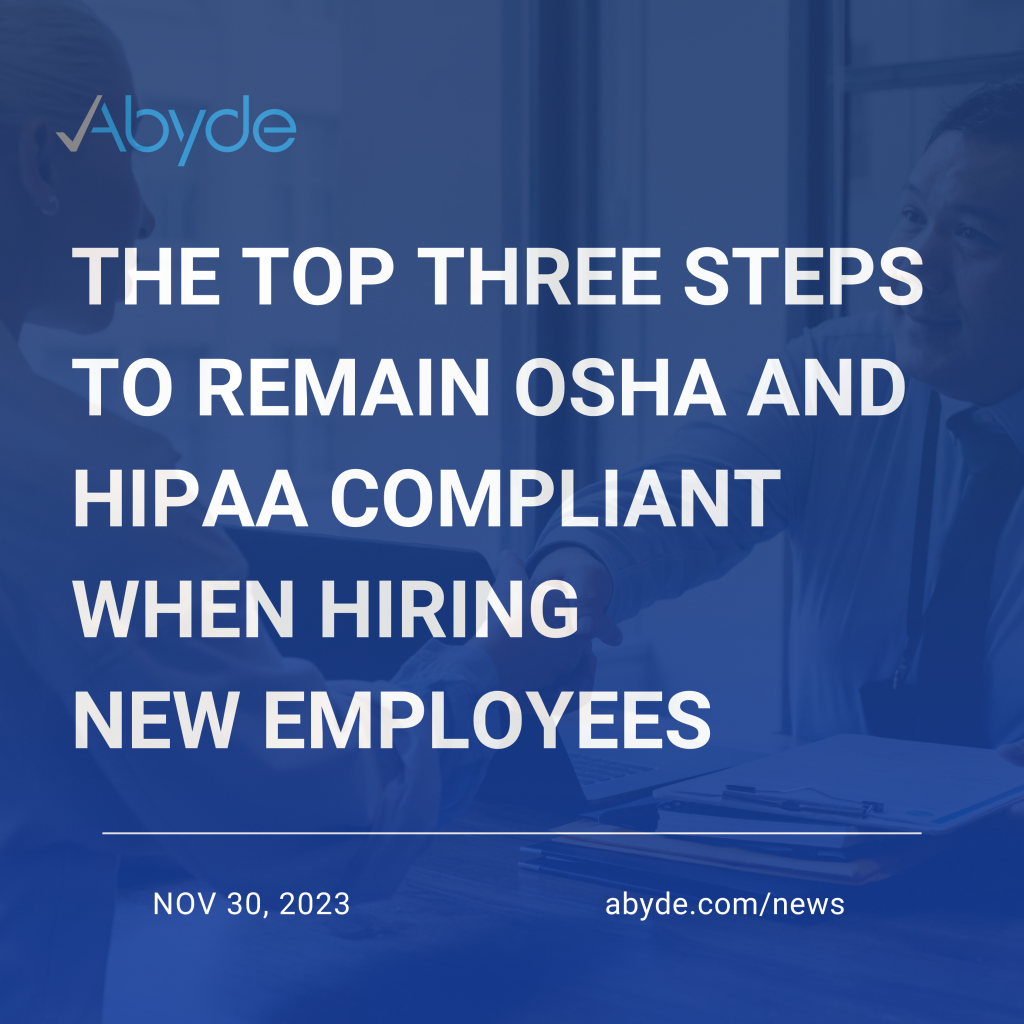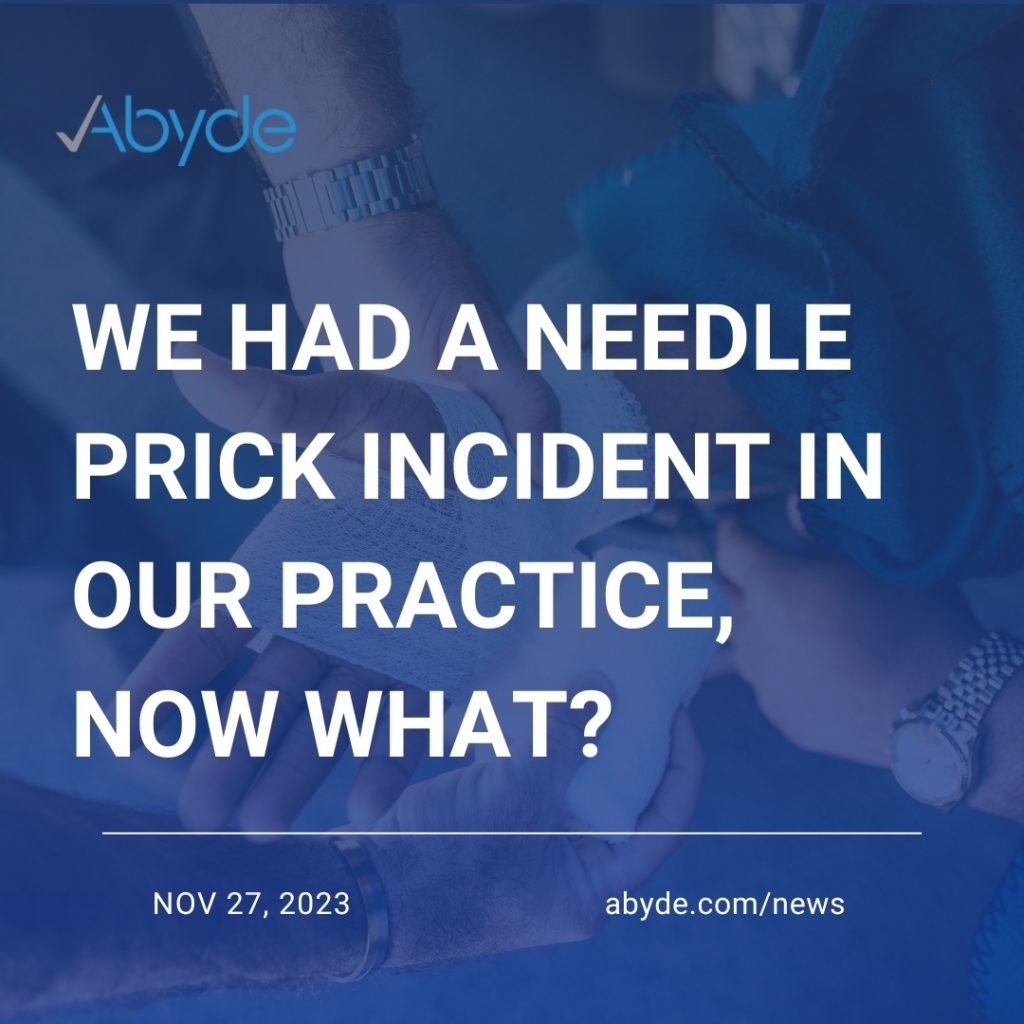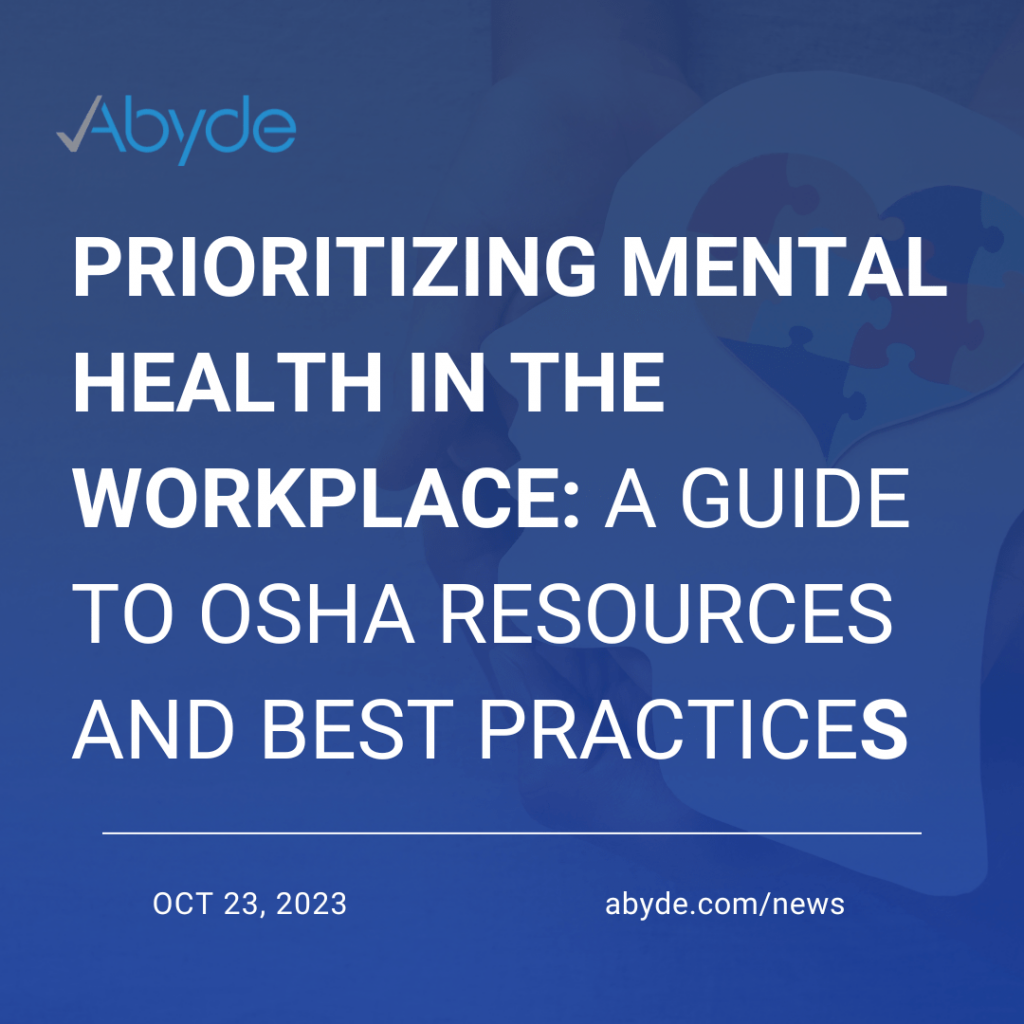February 16, 2024 The foundation of a strong healthcare practice lies in empowered healthcare workers. These individuals, from doctors and nurses to technicians and therapists, stand on the frontlines, safeguarding our health and well-being. However, with all the demands and complexities of their roles, it’s crucial to remember they have both rights and responsibilities. Read more to see how to empower healthcare workers and the positive benefits of a comprehensive compliance program in your practice. Understanding Worker Rights: Empowerment in Compliance Having a comprehensive compliance program is another way you can empower your team. Abyde can be your solution for this. Our software simplifies compliance and empowers healthcare professionals, allowing them to navigate compliance with ease. Our software includes entertaining training, intuitive security risk assessments, dynamically generated policies, and more. Our simplicity is our strength, empowering Abyde users to know their rights and responsibilities in compliance. To learn more about empowering your practice email info@abyde.com and schedule a demo today.
Staten Island Health Center Hit with $195K Fine for Silencing COVID Safety Whistleblower
January 31, 2024 Hi regulation rockstars! There have been some major new updates in OSHA fines. A Staten Island health center recently learned a $195,000 lesson on the importance of whistleblower protection during a global pandemic. What Happened: A Staten Island health center, Community Health Center of Richmond (CHCR), has been ordered to pay $195,000 to a former employee they illegally fired for raising concerns about an in-person staff meeting during the early days of the COVID-19 pandemic. Ouch. The Whistleblower: This brave employee, concerned about the health risks of an in-person meeting in March 2020, requested a teleconference instead. They even went ahead and changed the meeting format themselves. Talk about taking initiative! Retaliation Bites Back: Unfortunately, CHCR CEO Henry Thompson wasn’t having it. He insisted on the in-person meeting, putting the employee in a tough spot. Faced with the choice between their health and their job, the employee ultimately chose not to attend. But instead of understanding their concerns, CHCR suspended them for “insubordination” and then fired them shortly after. Yikes. OSHA Steps In: The employee, rightfully upset, filed a whistleblower complaint with OSHA. And guess what? OSHA investigated and found CHCR in violation of whistleblower protection laws. Big win for employee rights! The Payout: As part of a settlement, CHCR and Thompson are shelling out $195,000 to the employee, on top of other measures like: The Takeaway: This case sends a clear message: Employers can’t silence employees who raise safety concerns, especially during a pandemic. Here’s what this means for you: Remember, your health and safety matter. Don’t let employers bully you into silence. If you have concerns, speak up and know that you have rights. To learn more about your rights in the workplace, email info@abyde.com and schedule an educational consultation here.
The Increase in HIPAA and OSHA Fines in 2024
January 30, 2024 Well, my compliance crew, the cost of noncompliance just went up. As we all know, the costs of a HIPAA or OSHA violation can be detrimental to a practice. 2024 is bringing some hefty new financial burdens for organizations responsible for protecting patient privacy and worker safety. Buckle up, because increased fines for HIPAA and OSHA violations are here, and they’re not messing around. HIPAA: Your Data, Your Dollars The Department of Health and Human Services (HHS) has adjusted HIPAA civil monetary penalties for inflation, effective January 1st, 2024. This means: The message is clear: protecting patient privacy is more important than ever, and the government is willing to put its money where its mouth is. It’s time for healthcare providers and covered entities to beef up their data security measures and HIPAA compliance training. OSHA: Safety First, Fines Second OSHA hasn’t been shy about increasing its civil monetary penalties either, effective January 17th, 2024. Here’s the breakdown: These adjustments reflect the rising cost of workplace injuries and illnesses. Businesses across all industries need to prioritize safety protocols and employee training to avoid these financial penalties and potential lawsuits. Who Feels the Pinch? These increased fines impact various stakeholders: The Bottom Line: The 2024 fine hikes for HIPAA and OSHA violations are a wake-up call for organizations. While the financial implications are significant, neglecting compliance can be far costlier in terms of reputational damage, legal repercussions, and potential harm to individuals. That’s where Abyde can help your practice and organization. Abyde’s software can simplify compliance for you, with our software including training, risk assessments, dynamically generated policies and more. By proactively addressing these regulations, organizations can create a safer and more secure environment for everyone involved. Remember, compliance isn’t just about avoiding fines; it’s about building trust and protecting what matters most. So, be a compliance champion, not a cautionary tale. Make 2024 the year of safety, security, and peace of mind! To learn more about what you need to do to be compliant, email us at info@abyde.com and set up an educational consultation here.
2024 OSHA Law Updates for Healthcare
January 24, 2024 Greetings, safety champions! At Abyde, we’re obsessed with keeping workplaces hazard-free, which means staying on top of regulatory shifts like OSHA’s 2024 updates. So, grab your safety goggles and buckle up, because we’re about to unpack the need-to-know changes that impact your business. Electronic Injury Reporting Changes: OSHA is now requiring electronic injury reporting of Form 300 – Log of Work-Related Injuries and Illnesses, and Form 301 – Injury and Illness Incident Report for high-hazard industries with 100+ employees on a yearly basis. The Form 300A – Summary of Work-Related Injuries and Illnesses still also needs to be completed. In addition, all companies have to use their legal company names while filing these electronic reports to improve the quality of OSHA’s data. Increased Penalty Fines OSHA is throwing some serious punches when it comes to violations. As of January 16th, all OSHA’s maximum penalties increased from $15,625 per violation to $16,131 per violation. The maximum penalty for repeated violations will increase from $156,259 per violation to $161,323 per violation. Now, that’s one costly mistake! Changes to Hazard Communication Standard Last updated in 2012, It is expected that OSHA will finalize updates to the Hazard Communication Standard. The new HCS will align with the latest edition of the Globally Harmonized System of Classification and Labeling of Chemicals (GHS). This means a shift in how we categorize chemical dangers, with new hazard classes and pictograms potentially finding their way onto labels and Safety Data Sheets (SDSs). Championing Compliance with Abyde At Abyde, we’re your compliance crew, cheering you on every step of the way. We’ve got a toolbox full of resources to help you understand and promote a culture of compliance in your practice. For more information on how your organization can simplify OSHA compliance for your practice, email info@abyde.com or set up an compliance consultation here.
Demystifying Dosimetry Programs: What are they and why are they important for Medical Practices?
December 15, 2023 In the realm of medical practices, ensuring the safety and well-being of both patients and staff is paramount. As part of this commitment, understanding and implementing regulatory compliance measures is crucial. One such essential aspect is the Dosimetry Program, a structured system designed to monitor and assess occupational exposure to ionizing radiation. In this blog, we’ll delve into what Dosimetry Programs are, why they are vital for medical practices, and how Abyde simplifies compliance. What is a Dosimetry Program? A Dosimetry Program is a comprehensive framework aimed at monitoring and evaluating occupational exposure to ionizing radiation, a common concern in medical practices where diagnostic imaging and radiation therapy are routine. This program ensures that healthcare professionals, including radiologic technologists and other personnel, are not exposed to excessive levels of radiation during the course of their duties. Why are Dosimetry Programs Important for Medical Practices? How Abyde Helps Medical Practices Implement Dosimetry Programs Implementing and managing Dosimetry Programs can be intricate, but Abyde streamlines the process by providing: In conclusion, Dosimetry Programs are not just regulatory obligations for medical practices; they are integral to ensuring the safety of both staff and patients. Abyde’s OSHA solutions empower medical practices to streamline compliance efforts, prioritize employee safety, and build a robust foundation for a culture of patient-centered care. Stay compliant, stay secure, and stay Abyde. Reach out today to speak to one of our compliance experts! Call 800.594.0883 or email us at info@abyde.com!
OSHA Fine Alert: Workplace Violence in Healthcare is A Serious Threat
December 1, 2023 The recent OSHA investigation of a South Bay correctional facility highlights the ongoing problem of workplace violence in healthcare settings. The facility failed to implement proper safety protocols, resulting in a violent attack on a nurse by an inmate. This incident underscores the critical need for healthcare employers to prioritize worker safety and comply with OSHA regulations. Key Takeaways from the South Bay Incident: Abyde: Your Partner in Healthcare Compliance Abyde understands the unique challenges of healthcare organizations in ensuring worker safety and compliance. We offer a comprehensive suite of solutions to help: Protect Your Workers and Avoid Legal Ramifications Failing to prioritize workplace safety can have serious consequences for healthcare organizations, including legal action, fines, and reputational damage. By partnering with Abyde, you can proactively comply with regulations and create a safer environment for your staff. Click here to learn more about Abyde’s solutions for healthcare compliance and worker safety. Additional Resources:
The Top Three Steps to Remain OSHA and HIPAA Compliant when Hiring New Employees
November 30, 2023 In the fast-paced realm of healthcare, where patient confidentiality and workplace safety are paramount, hiring new staff demands meticulous attention to HIPAA and OSHA compliance. From the moment a new employee steps through the door, it’s crucial to instill a culture of compliance. Here’s a breakdown of the top three steps a medical practice should take during the onboarding process to ensure their team members are well-versed in compliance. 1. Training: The Foundation of Compliance Training is the bedrock of a compliant workforce. Before the employee even starts to perform job duties, invest time and resources in comprehensive training sessions that focus on both HIPAA and OSHA regulations. Abyde’s employee training portal can guide the creation of tailored training materials, ensuring that employees receive relevant, up-to-date information. Ensure that the training covers the nuances of patient privacy, proper handling of medical records, and the essential safety protocols mandated by OSHA. This also includes making sure employees who work with specialized equipment like X-ray machines, MRIs and lasers are trained specifically on each device. Regular updates and refresher courses can be facilitated through Abyde’s user-friendly employee portal, maintaining a continuous learning environment. 2. Confidentiality Agreements: Protecting Patient Privacy Securing patient information is at the core of HIPAA compliance. Implementing confidentiality agreements is a vital step in ensuring that new hires understand the gravity of safeguarding sensitive data. Clearly outline expectations regarding the handling of patient records, communication protocols, and consequences for breaches. Abyde can assist in streamlining this process by providing dynamically generated confidentiality agreements. Once signed, these agreements should be securely stored and easily accessible for future reference, ensuring that both parties are held accountable. 3. Access to Policies and Procedures: Empowering Informed Decision-Making Granting new employees easy access to your organization’s policies and procedures is essential for fostering informed decision-making. Abyde’s platform facilitates seamless accessibility, allowing employees to review and familiarize themselves with compliance guidelines at their own pace. This access is not only crucial during the onboarding process but should be an ongoing resource. Regular updates to policies and procedures can be effortlessly communicated through Abyde’s platform, ensuring that your team remains aligned with the latest compliance standards. In conclusion, successfully onboarding a new employee in a medical practice requires a strategic approach to compliance. By prioritizing training, confidentiality agreements, and access to policies and procedures, organizations can create a robust foundation for a compliant and secure workplace. Abyde’s innovative solutions streamline these processes, empowering medical practices to navigate the complexities of HIPAA and OSHA compliance with confidence.Interested in seeing the Abyde solution in action? Click here to schedule a demo or call us at 1800-594-0883.
We Had a Needle Prick Incident in Our Practice, Now What?
November 27, 2023 Accidents happen, and in a medical setting, a needle prick can be a cause for concern. As a responsible healthcare provider, it’s crucial to have a clear protocol in place for your team to follow when such incidents occur. In this guide, we’ll walk you through the top four things your medical practice must do after a needle prick to ensure the well-being of your staff and maintain compliance. 1. Provide First Aid to the Employee If Needed: The safety and well-being of your staff are paramount. In the event of a needle prick, provide immediate first aid to the affected employee. Ensure that basic first aid supplies are readily available, and educate your team on the proper procedures to address minor injuries. Quick and appropriate action can significantly reduce the risk of complications. 2. Recommend the Employee Seek Medical Attention: While first aid is a crucial initial step, it’s essential to recommend that the affected employee seek professional medical attention promptly. Urgent care facilities or other medical providers can conduct a thorough assessment of the situation and determine if further medical interventions, such as post-exposure prophylaxis (PEP), are necessary. Prompt medical attention is vital for minimizing potential health risks. 3. Ask the Source Patient for Consent to Test Their Blood: One of the critical steps after a needle prick is to assess the risk of bloodborne pathogens. Seeking consent from the source patient for blood testing is a crucial component of this assessment. Utilize the Accidental Exposure Testing Consent Form provided by Abyde to ensure that the process is well-documented and compliant. This form not only demonstrates your commitment to employee health but also facilitates a transparent and legally sound approach to managing potential exposures. 4. Log Incident within Abyde: To maintain a comprehensive record of the incident and demonstrate compliance with industry standards, it’s imperative to log the needle prick incident within Abyde. Abyde’s robust compliance solutions are designed to streamline documentation processes and ensure that all necessary details are recorded accurately. By logging the incident promptly, you create a valuable resource for future reference, audits, and continuous improvement of your workplace safety protocols. Conclusion: Prioritizing Safety and Compliance Handling a needle prick incident promptly and responsibly is crucial for the safety of your staff and the integrity of your medical practice. By providing immediate first aid, recommending professional medical attention, seeking consent for blood testing, and logging the incident within Abyde, you establish a robust framework for managing such situations. Abyde’s commitment to simplifying compliance processes ensures that your medical practice can navigate post-needle prick protocols seamlessly. Remember, proactive measures today contribute to a safer and more compliant healthcare environment tomorrow. Not yet using Abyde? Click here to schedule a one-on-one consultation with a compliance expert!
Prioritizing Mental Health in the Workplace: A Guide to OSHA Resources and Best Practices
October 23, 2023 The modern workplace can often be a breeding ground for stress, anxiety, and other mental health concerns. In fact, 80% of employees experience some form of stress at work. Mental well-being can take a backseat as employers and workers grapple with deadlines, interpersonal conflicts, and work-life balance. However, it’s essential to prioritize mental health for overall productivity and harmony within an organization. Abyde, a leader in HIPAA and OSHA compliance solutions, aims to shed light on the importance of this topic and the valuable resources provided by the Occupational Safety and Health Administration (OSHA) to help organizations build a healthier work environment. The Importance of Mental Health Awareness Talking openly about mental health is the first step toward reducing the stigma surrounding it. Employers, unions, and worker organizations have a vital role to play in this discourse. From educational initiatives to supportive policies, these bodies should invest in strategies that focus on: OSHA Resources to Support Workplace Mental Health Support One Another Toolkit This toolkit provides comprehensive guidelines for creating a workplace culture encourages mental health discussions. Available in both English and Spanish, it is an excellent resource for initiating dialogues around mental well-being. Working Together Poster A handy resource for employers and workers alike, this poster outlines the essential steps to address workplace stress and mental health issues effectively. Supporting Your Co-Workers Poster Compassion and understanding are essential when talking about mental health. This poster offers concrete tips on approaching such sensitive topics respectfully, listening empathetically, and providing meaningful support to co-workers. Worker-Fatigue Webpage Worker fatigue is often a precursor to more serious mental health concerns. OSHA’s dedicated webpage on this issue includes information on the impact of demanding work schedules and offers recommendations for preventing fatigue-related injuries and illnesses. Helping Your Co-Workers and Yourself Poster Focusing on mutual support, this poster provides general tips and advice for employers and employees to help each other cope with stress and mental health challenges. Building an Awareness Campaign The resources mentioned above can serve as building blocks for an effective mental health awareness campaign within your organization. OSHA also has written a guide for managers discussing mental health challenges with their employees. Employers can customize these resources to suit their specific workplace environment and challenges. Final Thought Promoting mental health in the workplace is a collective responsibility requiring concerted efforts from employers, workers, and organizations. Utilizing the resources provided by OSHA can help lay a strong foundation for a mentally healthy work environment. Integrating these OSHA resources into your workplace policies and practices ensures a healthier, more productive team and remains compliant with safety and health standards, a win-win situation for all. For more information on how to make your workplace OSHA-compliant and employee-friendly, visit Abyde. We offer comprehensive solutions that effortlessly ensure you meet all health and safety standards.
Emerging OSHA Regulations: What to Expect in the Coming Years
October 13, 2023 Introduction The Occupational Safety and Health Administration (OSHA) is a dynamic organization, constantly updating its regulations and guidelines to reflect the evolving landscape of workplace safety and health. As a covered entity, staying ahead of these changes is not just a matter of compliance; it’s a commitment to the well-being of your workforce. In this article, we will delve into what to expect in the realm of emerging OSHA regulations and how you can prepare for them. The Ongoing Pandemic’s Impact The COVID-19 pandemic has had a profound impact on workplace safety protocols. While some temporary measures may be phased out, others, such as enhanced sanitation and air quality guidelines, could become permanent fixtures of OSHA regulations. Companies may need to invest in better HVAC systems or air purifiers to ensure a safe working environment. Technological Advances With advancements in technology, OSHA is likely to adopt more data-driven approaches. Implementing wearables that monitor employee posture, heart rate, or exposure to harmful substances may become commonplace. This data could be invaluable for both employers and OSHA in assessing workplace safety levels and compliance. Mental Health Considerations As awareness around mental health grows, OSHA may introduce regulations that address workplace stress, bullying, and other mental health issues. This could require employers to provide mental health resources or training programs to reduce workplace stress. Green Initiatives With an increasing focus on sustainable practices, future OSHA regulations could require companies to adopt eco-friendly measures. These could range from waste management to using green materials in construction and manufacturing processes. Failure to adopt such measures could result in fines and damage to a company’s reputation. Increased Fines and Penalties The trend has been clear: OSHA is increasing fines and penalties for non-compliance. The financial repercussions of failing to adhere to OSHA regulations will likely become more severe, making compliance a financial imperative as much as a moral and legal one. Gig Economy and Remote Work The rise of the gig economy and remote work poses new challenges for OSHA. Traditional regulations focusing on physical workplaces may evolve to include home offices or shared workspace guidelines. Such guidelines may concern ergonomic setups, electrical safety, and even cybersecurity. Preparation for Emerging Regulations Conclusion As the nature of work evolves, so will OSHA regulations. By staying ahead of these changes, you protect your employees and shield your organization from potential legal complications and fines. The future may be uncertain, but preparation and attentiveness will go a long way in navigating the complexities of emerging OSHA regulations.By equipping yourself with the knowledge and tools to adapt to these new norms, you’re not just complying with the law but also making a long-term investment in the health and safety of your workforce. Need help or have questions? Click here to schedule a complimentary compliance consultation with an expert today!
